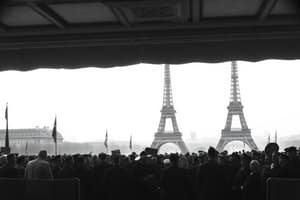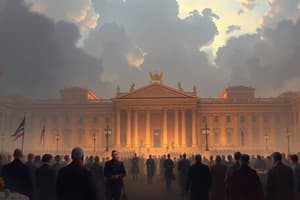Podcast
Questions and Answers
Who were the main Allied powers represented at the 1919 Paris Peace Conference?
Who were the main Allied powers represented at the 1919 Paris Peace Conference?
- Theodore Roosevelt, Herbert Hoover, Woodrow Wilson, Queen Victoria
- Franklin Roosevelt, Winston Churchill, Joseph Stalin, Charles de Gaulle
- Woodrow Wilson, David Lloyd George, Georges Clemenceau, Vittorio Orlando (correct)
- George Washington, John Adams, Thomas Jefferson, Benjamin Franklin
What major health issues did Dr. William Gorgas address during the construction of the Panama Canal?
What major health issues did Dr. William Gorgas address during the construction of the Panama Canal?
- Yellow fever and malaria (correct)
- Tuberculosis and pneumonia
- Cholera and typhoid fever
- Smallpox and measles
What did the 1854 Treaty of Kanagawa accomplish for Japan?
What did the 1854 Treaty of Kanagawa accomplish for Japan?
- It established a military alliance with the U.S.
- It marked the end of the Edo period.
- It introduced Western education in Japan.
- It forced Japan to open to foreign trade. (correct)
What is the principle of self-determination as promoted by Woodrow Wilson?
What is the principle of self-determination as promoted by Woodrow Wilson?
What concept suggested that Western powers had a duty to civilize non-white populations?
What concept suggested that Western powers had a duty to civilize non-white populations?
Which regiment fought under French command during WWI and was recognized for its bravery?
Which regiment fought under French command during WWI and was recognized for its bravery?
What was one of Woodrow Wilson's key contributions during his presidency related to international relations?
What was one of Woodrow Wilson's key contributions during his presidency related to international relations?
What best describes the U.S. foreign policy stance before and after WWI?
What best describes the U.S. foreign policy stance before and after WWI?
Which law limited Cuba's sovereignty after the Spanish-American War?
Which law limited Cuba's sovereignty after the Spanish-American War?
What event triggered the start of World War I?
What event triggered the start of World War I?
Which statement accurately describes labor conditions during WWI?
Which statement accurately describes labor conditions during WWI?
What was a significant consequence of the 1918 influenza pandemic?
What was a significant consequence of the 1918 influenza pandemic?
What was the main outcome of the Philippine-American War?
What was the main outcome of the Philippine-American War?
What does the Sussex Pledge refer to?
What does the Sussex Pledge refer to?
What was a primary reason for the U.S. intervention in the Mexican Revolution?
What was a primary reason for the U.S. intervention in the Mexican Revolution?
What was the objective of General Pershing's strategy during WWI?
What was the objective of General Pershing's strategy during WWI?
Which of the following characterized battles during WWI?
Which of the following characterized battles during WWI?
What was a significant aspect of the Boxer Rebellion?
What was a significant aspect of the Boxer Rebellion?
What significant public health challenge occurred during the construction of the Panama Canal?
What significant public health challenge occurred during the construction of the Panama Canal?
Which statement describes the influence of propaganda during WWI?
Which statement describes the influence of propaganda during WWI?
What was the main outcome of the abdication of Kaiser Wilhelm II in 1918?
What was the main outcome of the abdication of Kaiser Wilhelm II in 1918?
Which U.S. President opposed the annexation of Hawaii?
Which U.S. President opposed the annexation of Hawaii?
Flashcards
The Big Four: Woodrow Wilson, David Lloyd George, Georges Clemenceau, Vittorio Orlando
The Big Four: Woodrow Wilson, David Lloyd George, Georges Clemenceau, Vittorio Orlando
The four main Allied powers in WWI (U.S., U.K., France, Italy) who met at the Paris Peace Conference to negotiate the Treaty of Versailles. They shaped the treaty, ended the war, and redrew Europe's map.
Dr. William Gorgas
Dr. William Gorgas
A U.S. Army physician who played a crucial role in eliminating yellow fever and malaria in Panama, making the construction of the Panama Canal possible and saving countless lives.
Edo Period in Pre-1854 Japan
Edo Period in Pre-1854 Japan
The period in Japanese history before 1854 when Japan was isolated and had limited contact with the outside world. It ended with the Treaty of Kanagawa, which forced Japan to open its doors to trade and paved the way for its modernization and expansion.
Self-Determination
Self-Determination
Signup and view all the flashcards
White Man's Burden
White Man's Burden
Signup and view all the flashcards
Harlem Hellfighters (369th Infantry Regiment)
Harlem Hellfighters (369th Infantry Regiment)
Signup and view all the flashcards
Isolationism
Isolationism
Signup and view all the flashcards
League of Nations
League of Nations
Signup and view all the flashcards
Platt Amendment
Platt Amendment
Signup and view all the flashcards
Archduke Franz Ferdinand
Archduke Franz Ferdinand
Signup and view all the flashcards
Labor Conditions During WWI
Labor Conditions During WWI
Signup and view all the flashcards
Influenza Epidemic of 1918
Influenza Epidemic of 1918
Signup and view all the flashcards
President Roosevelt and the Philippines
President Roosevelt and the Philippines
Signup and view all the flashcards
President Cleveland and Hawaii
President Cleveland and Hawaii
Signup and view all the flashcards
German Emperor Abdicates (WWI)
German Emperor Abdicates (WWI)
Signup and view all the flashcards
German Peace Offensive (WWI)
German Peace Offensive (WWI)
Signup and view all the flashcards
Buffalo Soldiers
Buffalo Soldiers
Signup and view all the flashcards
U.S. and Mexico Relations
U.S. and Mexico Relations
Signup and view all the flashcards
Victoriano Huerta
Victoriano Huerta
Signup and view all the flashcards
Spanish-American War
Spanish-American War
Signup and view all the flashcards
General Pershing's Strategy (WWI)
General Pershing's Strategy (WWI)
Signup and view all the flashcards
Selective Service Act (WWI)
Selective Service Act (WWI)
Signup and view all the flashcards
Study Notes
World War I and Related Events
- The "Big Four" at the Paris Peace Conference included Woodrow Wilson (US), David Lloyd George (UK), Georges Clemenceau (France), and Vittorio Orlando (Italy). These leaders shaped the Treaty of Versailles.
- Dr. William Gorgas eradicated yellow fever and malaria in Panama, enabling the Panama Canal's construction.
- Before 1854, Japan was isolated. The 1854 Treaty of Kanagawa forced Japan to open to trade, initiating its modernization and global power rise.
- Self-determination, championed by Wilson, is the principle that nations should govern themselves without outside interference.
- The "White Man’s Burden" justifies Western power's role in civilizing other nations, often used to support colonialism.
- The Harlem Hellfighters, the 369th Infantry, were a highly decorated black U.S. regiment in WWI, serving under French command.
- Woodrow Wilson, the 28th U.S. President, promoted the League of Nations, self-determination, and the 14 Points plan during WWI.
- Isolationism was a dominant U.S. foreign policy before and after WWI, advocating avoidance of international conflicts.
- The League of Nations was an international peace organization formed after WWI to avert future wars. The US did not join.
- Alaska was bought from Russia in 1867 for $7.2 million, becoming strategically important.
- The Platt Amendment limited Cuba's independence after the Spanish-American War, allowing U.S. intervention.
- Archduke Franz Ferdinand's assassination in 1914 triggered WWI.
- WWI labor conditions improved due to wartime demand, but workers faced long hours, poor conditions, and low wages. Unions gained more power.
- The 1918 influenza pandemic (Spanish flu) spread worldwide, killing millions, impacting global health and impacting soldiers returning from WWI.
- Theodore Roosevelt oversaw the Philippine-American War (1899-1902) after the U.S. annexed the Philippines.
- Grover Cleveland opposed the annexation of Hawaii after an American takeover of the monarchy.
- Kaiser Wilhelm II abdicated in 1918, ending the German Empire and starting the Weimar Republic.
Other Key Events and Figures
- The German Spring Offensive of 1918 failed, highlighting the inability of Germany to decisively impact the war before the full American arrival.
- Buffalo Soldiers were African-American soldiers who served in the US Army in the West after the Civil War.
- Tensions between the U.S. and Mexico involved the Mexican-American War (1846-48), U.S. intervention in the Mexican Revolution, and General Pershing's 1916 expedition to pursue Pancho Villa.
- Victoriano Huerta seized power in a 1913 Mexican coup but faced opposition from the U.S. and Mexican revolutionaries.
- The Spanish-American War (1898) led to US control of Puerto Rico, Guam, and the Philippines, establishing the U.S. as a global power.
- General Pershing's strategy for WWI focused on offensive actions and coordination with Allied forces, favoring independent American operations.
- The Selective Service Act (1917) allowed the U.S. to draft soldiers during WWI.
- European powers anticipated a swift war, unprepared for WWI's protracted trench warfare, extensive casualties, and new technologies.
- Propaganda was used to support war efforts, raise nationalism, and damage the enemy's image.
- The USS Maine explosion of 1898, likely accidental, escalated conflicts with Spain, triggering the Spanish-American War.
- WWI battles involved trench warfare, immense casualties, and technological innovations such as machine guns, poison gas, tanks and airplanes.
- The Sussex Pledge was a 1916 German promise to stop unrestricted submarine warfare, but it was broken, contributing to the US joining the war.
- Taft vs. Roosevelt (1912) presidential race resulted in a split Republican vote, allowing Wilson's election.
- Spanish General Valeriano Weyler's brutal tactics during the Cuban Insurrection increased public support for Cuban independence.
- Opposition to WWI included socialists like Eugene Debs who viewed the war as benefiting capitalists.
- U.S. democracy was questioned by critics who highlighted racial inequality, imperialism, and wartime compromises on civil liberties.
- In Panama, disease like yellow fever and malaria created significant problems during the construction of the Panama Canal; Dr. Gorgas's strategies addressed the spread of these diseases.
- The Russian Revolution (1917) removed Russia from WWI, installed a communist government, and paved the way for the formation of the Soviet Union.
Other Topics
- The Panama Canal, completed in 1914, connected the Atlantic and Pacific Oceans, boosting global trade and military mobility.
- The Boxer Rebellion (1900) in China was an anti-imperialist uprising, and the U.S. joined the international response.
Studying That Suits You
Use AI to generate personalized quizzes and flashcards to suit your learning preferences.




